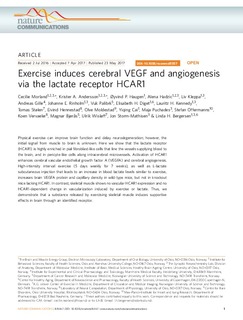| dc.contributor.author | Morland, Cecilie | |
| dc.contributor.author | Andersson, Krister | |
| dc.contributor.author | Haugen, Øyvind Pernell | |
| dc.contributor.author | Hadzic, Alena | |
| dc.contributor.author | Kleppa, Liv | |
| dc.contributor.author | Gille, Andreas | |
| dc.contributor.author | Rinholm, Johanne Egge | |
| dc.contributor.author | Palibrk, Vuk | |
| dc.contributor.author | Diget, Elisabeth Holm | |
| dc.contributor.author | Kennedy, Lauritz Hagen | |
| dc.contributor.author | Stølen, Tomas | |
| dc.contributor.author | Hennestad, Eivind | |
| dc.contributor.author | Moldestad, Olve | |
| dc.contributor.author | Cai, Yiqing | |
| dc.contributor.author | Puchades, Maja Amedjkouh | |
| dc.contributor.author | Offermanns, Stefan | |
| dc.contributor.author | Vervaeke, Koen Gerard Alois | |
| dc.contributor.author | Bjørås, Magnar | |
| dc.contributor.author | Wisløff, Ulrik | |
| dc.contributor.author | Storm-Mathisen, Jon | |
| dc.contributor.author | Bergersen, Linda Hildegard | |
| dc.date.accessioned | 2017-08-16T08:07:24Z | |
| dc.date.available | 2017-08-16T08:07:24Z | |
| dc.date.created | 2017-07-31T17:25:42Z | |
| dc.date.issued | 2017 | |
| dc.identifier.issn | 2041-1723 | |
| dc.identifier.uri | http://hdl.handle.net/11250/2450849 | |
| dc.description.abstract | Physical exercise can improve brain function and delay neurodegeneration; however, the initial signal from muscle to brain is unknown. Here we show that the lactate receptor (HCAR1) is highly enriched in pial fibroblast-like cells that line the vessels supplying blood to the brain, and in pericyte-like cells along intracerebral microvessels. Activation of HCAR1 enhances cerebral vascular endothelial growth factor A (VEGFA) and cerebral angiogenesis. High-intensity interval exercise (5 days weekly for 7 weeks), as well as L-lactate subcutaneous injection that leads to an increase in blood lactate levels similar to exercise, increases brain VEGFA protein and capillary density in wild-type mice, but not in knockout mice lacking HCAR1. In contrast, skeletal muscle shows no vascular HCAR1 expression and no HCAR1-dependent change in vascularization induced by exercise or lactate. Thus, we demonstrate that a substance released by exercising skeletal muscle induces supportive effects in brain through an identified receptor. | nb_NO |
| dc.language.iso | eng | nb_NO |
| dc.publisher | Nature Publishing Group | nb_NO |
| dc.rights | Navngivelse 4.0 Internasjonal | * |
| dc.rights.uri | http://creativecommons.org/licenses/by/4.0/deed.no | * |
| dc.title | Exercise induces cerebral VEGF and angiogenesis via the lactate receptor HCAR1 | nb_NO |
| dc.type | Journal article | nb_NO |
| dc.type | Peer reviewed | nb_NO |
| dc.description.version | publishedVersion | nb_NO |
| dc.source.volume | 8 | nb_NO |
| dc.source.journal | Nature Communications | nb_NO |
| dc.identifier.doi | 10.1038/ncomms15557 | |
| dc.identifier.cristin | 1483542 | |
| dc.description.localcode | © The Author(s) 2017. This work is licensed under a Creative Commons Attribution 4.0 International License. The images or other third party material in this article are included in the article’s Creative Commons license, unless indicated otherwise in the credit line; if the material is not included under the Creative Commons license,users will need to obtain permission from the license holder to reproduce the material.To view a copy of this license, visit http://creativecommons.org/licenses/by/4.0/r | nb_NO |
| cristin.unitcode | 194,65,15,0 | |
| cristin.unitcode | 194,65,25,0 | |
| cristin.unitname | Institutt for kreftforskning og molekylær medisin | |
| cristin.unitname | Institutt for sirkulasjon og bildediagnostikk | |
| cristin.ispublished | true | |
| cristin.fulltext | original | |
| cristin.qualitycode | 2 | |

